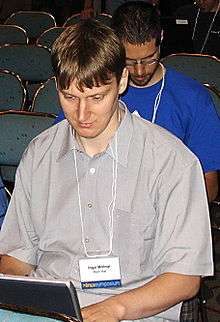Ingo Molnár
| Ingo Molnár | |
|---|---|
 | |
| Nationality | Hungarian |
| Occupation | Programmer |
| Employer | Red Hat |
| Known for | Completely Fair Scheduler |
Ingo Molnár, employed by Red Hat as of May 2013,[1] is a Hungarian Linux hacker. He is best known for his contributions to the operating system in terms of security and performance.
Life and career
Molnár studied at Eötvös Loránd University.
Work
Some of his additions to the Linux kernel include the O(1) scheduler of Linux-2.6.0 and the Completely Fair Scheduler of Linux-2.6.23, the in-kernel TUX HTTP / FTP server, as well as his work to enhance thread handling.[2] He also wrote a kernel security feature called "Exec Shield", which prevents stack-based buffer overflow exploits in the x86 architecture by disabling the execute permission for the stack.
Together with Thomas Gleixner, he worked on the real-time preemption (PREEMPT_RT) patch set, which aims to reduce the maximum thread switching latency of the Linux kernel from an unbounded number of milliseconds to down to bounded values in the order of tens of microseconds (depending on the system). As of 2011, Thomas Gleixner is working on further improving the patch and getting important infrastructure patches of the patch set merged into the Mainline Linux kernel.
Between Linux 2.6.21 and Linux 2.6.24, he worked on the Completely Fair Scheduler (CFS) which was inspired by the scheduler work of Con Kolivas. CFS replaced the previous process scheduler of the Linux kernel with Linux-2.6.23.[3]
In 2012 Molnar criticized the Linux desktop as "not free enough" for the users with respect to the applications. He argues that the typically used system of software distribution and deployment by a centrally organized Linux distributions is not fast and flexible enough to satisfy the requirements of users and application producers alike.[4] Molnár suggests a decentral deployment method (similar to Autopackage, Zero Install,[5] or the Klik-successor PortableLinuxApps[6]) which allows a more flexible application infrastructure formed by a stable platform and independent software providers.[7]
Quotes
On the question, why the Linux desktop hasn’t been adopted by the mainstream users yet:
| “ | The basic failure of the free Linux desktop is that it's, perversely, not free enough...
Desktop Linux distributions are trying to "own" 20 thousand application packages consisting of over a billion lines of code and have created parallel, mostly closed ecosystems around them... The Linux package management method system works reasonably well in the enterprise (which is a hierarchical, centrally planned organization in most cases), but desktop Linux on the other hand stopped scaling 10 years ago, at the 1000 packages limit... |
” |
References
- ↑ Ingo Molnár's Google Plus page. Retrieved on 2015-Feb-11
- ↑ KernelTrap interview with Ingo Molnár (2002-12-03)
- ↑ Linux: Completely Fair Scheduler Merged (2007-07-10)
- ↑ Molnar, Ingo (2012-03-17). "Technology: What ails the Linux desktop? Part I.". plus.google.com. Retrieved 2012-06-16.
The basic failure of the free Linux desktop is that it's, perversely, not free enough. There's been a string of Linux desktop quality problems, specific incidents reported by +Linas Vepstas , +Jon Masters , +Linus Torvalds and others, and reading the related G+ discussions made me aware that many OSS developers don't realize what a deep hole we are in. The desktop Linux suckage we are seeing today - on basically all the major Linux distributions - are the final symptoms of mistakes made 10-20 years ago - the death cries of a platform. Desktop Linux distributions are trying to "own" 20 thousand application packages consisting of over a billion lines of code and have created parallel, mostly closed ecosystems around them. The typical update latency for an app is weeks for security fixes (sometimes months) and months (sometimes years) for major features. They are centrally planned, hierarchical organizations instead of distributed, democratic free societies.
- ↑ Leonard, Thomas (2007-01-16). "Decentralised Installation Systems". osnews.com. Retrieved 2012-05-03.
- ↑ Peter, Simon (2010). "AppImageKit Documentation 1.0" (pdf). PortableLinuxApps.org. pp. 2–3. Retrieved 2011-07-29.
Linux distributions mostly use package managers for everything. While this is perceived superior to Windows and the Mac by many Linux enthusiasts, it also creates a number of disadvantages: Centralization [...], Duplication of effort [...], Need to be online [...], No recent apps on mature operating systems [...], No way to use multiple versions in parallel [...], Not easy to move an app from one machine to another [...]. The AppImage format has been created with specific objectives in mind: Be distribution-agnostic [...], Maintain binary compatibility [...]
- ↑ Ingo Molnar (2012-03-17). "Technology: What ails the Linux desktop? Part II.". plus.google.com. Retrieved 2012-06-16.
So, to fix desktop Linux we need a radically different software distribution model: less of a cathedral, more of a bazaar. [...] - totally flat package dependencies (i.e. a package update does not forcibly pull in other package updates) [...] - a guaranteed ABI platform going forward (once a package is installed it will never break or require forced updates again). Users want to be free of update pressure from the rest of the system, if they choose to.
External links
- Ingo Molnár's homepage at Red Hat
- Ingo Molnár's RT-kernel homepage
- The RT-kernel Wiki
- Ingo LKML activity